Page 261 of 514
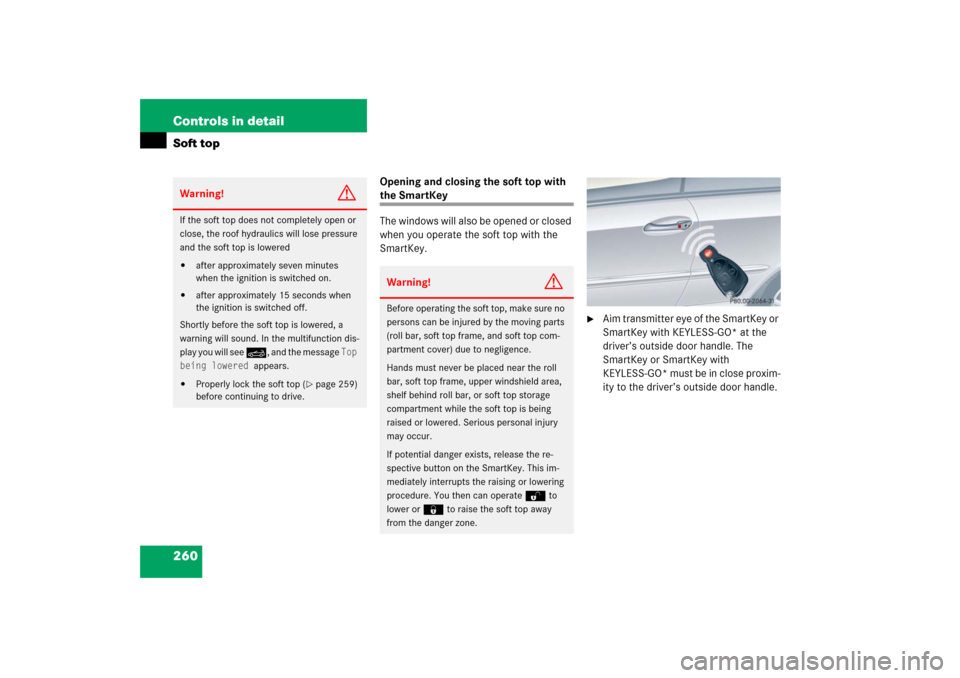
260 Controls in detailSoft top
Opening and closing the soft top with the SmartKey
The windows will also be opened or closed
when you operate the soft top with the
SmartKey.
�
Aim transmitter eye of the SmartKey or
SmartKey with KEYLESS-GO* at the
driver’s outside door handle. The
SmartKey or SmartKey with
KEYLESS-GO* must be in close proxim-
ity to the driver’s outside door handle.
Warning!
G
If the soft top does not completely open or
close, the roof hydraulics will lose pressure
and the soft top is lowered�
after approximately seven minutes
when the ignition is switched on.
�
after approximately 15 seconds when
the ignition is switched off.
Shortly before the soft top is lowered, a
warning will sound. In the multifunction dis-
play you will see K, and the message
Top
being lowered
appears.
�
Properly lock the soft top (
�page 259)
before continuing to drive.
Warning!
G
Before operating the soft top, make sure no
persons can be injured by the moving parts
(roll bar, soft top frame, and soft top com-
partment cover) due to negligence.
Hands must never be placed near the roll
bar, soft top frame, upper windshield area,
shelf behind roll bar, or soft top storage
compartment while the soft top is being
raised or lowered. Serious personal injury
may occur.
If potential danger exists, release the re-
spective button on the SmartKey. This im-
mediately interrupts the raising or lowering
procedure. You then can operate Πto
lower or ‹to raise the soft top away
from the danger zone.
Page 262 of 514
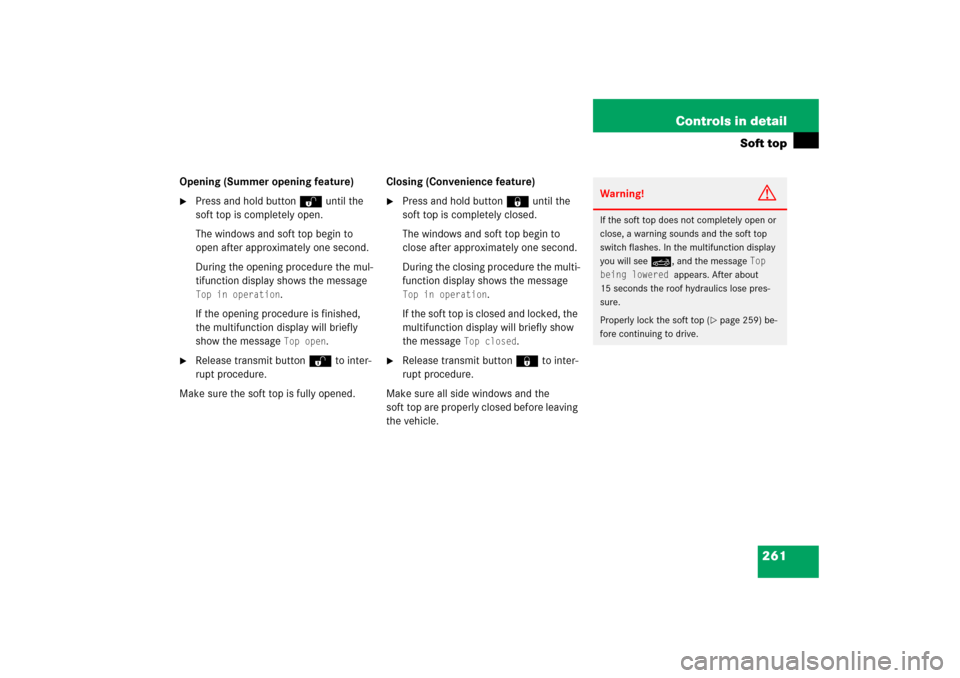
261 Controls in detail
Soft top
Opening (Summer opening feature)�
Press and hold button Πuntil the
soft top is completely open.
The windows and soft top begin to
open after approximately one second.
During the opening procedure the mul-
tifunction display shows the message Top in operation
.
If the opening procedure is finished,
the multifunction display will briefly
show the message Top open
.
�
Release transmit button Πto inter-
rupt procedure.
Make sure the soft top is fully opened.Closing (Convenience feature)
�
Press and hold button ‹until the
soft top is completely closed.
The windows and soft top begin to
close after approximately one second.
During the closing procedure the multi-
function display shows the message Top in operation
.
If the soft top is closed and locked, the
multifunction display will briefly show
the message
Top closed
.
�
Release transmit button ‹to inter-
rupt procedure.
Make sure all side windows and the
soft top are properly closed before leaving
the vehicle.
Warning!
G
If the soft top does not completely open or
close, a warning sounds and the soft top
switch flashes. In the multifunction display
you will see K, and the message
Top
being lowered
appears. After about
15 seconds the roof hydraulics lose pres-
sure.
Properly lock the soft top (
�page 259) be-
fore continuing to drive.
Page 264 of 514
263 Controls in detail
Soft top
Wind screen
The wind screen deflects drafts away from
the driver and passenger when the soft top
is lowered. It is stored in a separate stor-
age bag in the trunk.Installing
�
Remove the wind screen from its stor-
age bag.
1Upper section
2Lower section
�
Fold sections1 and2 together.3Catch
4Retainer claw
5Snap fastener
�
Press retainer claw4 on upper sec-
tion into snap fastener5 of lower sec-
tion.
Warning!
G
The wind screen can restrict the driver’s vi-
sion to the rear of the vehicle. To prevent a
possible accident when visibility is limited
(e.g. in darkness), the upper part of the wind
screen should be folded back.
��
Page 265 of 514
264 Controls in detailSoft top6Retaining lugs
7Mounting fixture on right side
8Catch�
Fold retaining lugs6 out.
�
Slide pre-assembled wind screen into
mounting fixture on right side7 using
retaining pin on right side. Simulta-
neously, retaining lugs6 should slide
into seat belt passage in rear bench
seat.
�
Pull catch8 back and guide left re-
taining pin into mounting fixture on left
side.
�
Fold upper section of wind screen up
toward head restraints until it stops.Removing
�
Fold upper section of wind screen back
down.
�
Pull catch8 back and pull wind
screen out toward front of vehicle. Be
careful not to damage interior trim with
guide tabs.
�
Fold retaining lugs6 back.
9Catch
�
Press catch 9 and fold upper and low-
er sections back.
�
Place the wind screen back into the
bag.
Warning!
G
Check for secure locking by pulling up on
the wind screen.
To prevent personal injury, remove wind
screen if rear seats are to be occupied by
passengers.
��
Page 266 of 514
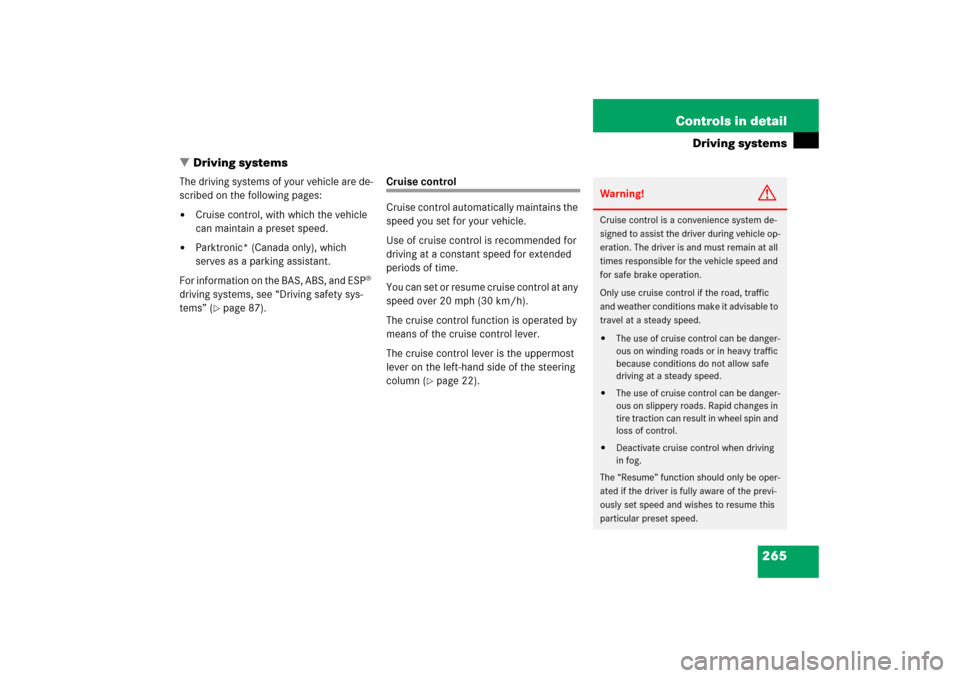
265 Controls in detail
Driving systems
�Driving systems
The driving systems of your vehicle are de-
scribed on the following pages:�
Cruise control, with which the vehicle
can maintain a preset speed.
�
Parktronic* (Canada only), which
serves as a parking assistant.
For information on the BAS, ABS, and ESP
®
driving systems, see “Driving safety sys-
tems” (
�page 87).
Cruise control
Cruise control automatically maintains the
speed you set for your vehicle.
Use of cruise control is recommended for
driving at a constant speed for extended
periods of time.
You can set or resume cruise control at any
speed over 20 mph (30 km/h).
The cruise control function is operated by
means of the cruise control lever.
The cruise control lever is the uppermost
lever on the left-hand side of the steering
column (
�page 22).
Warning!
G
Cruise control is a convenience system de-
signed to assist the driver during vehicle op-
eration. The driver is and must remain at all
times responsible for the vehicle speed and
for safe brake operation.
Only use cruise control if the road, traffic
and weather conditions make it advisable to
travel at a steady speed.�
The use of cruise control can be danger-
ous on winding roads or in heavy traffic
because conditions do not allow safe
driving at a steady speed.
�
The use of cruise control can be danger-
ous on slippery roads. Rapid changes in
tire traction can result in wheel spin and
loss of control.
�
Deactivate cruise control when driving
in fog.
The “Resume” function should only be oper-
ated if the driver is fully aware of the previ-
ously set speed and wishes to resume this
particular preset speed.
Page 267 of 514
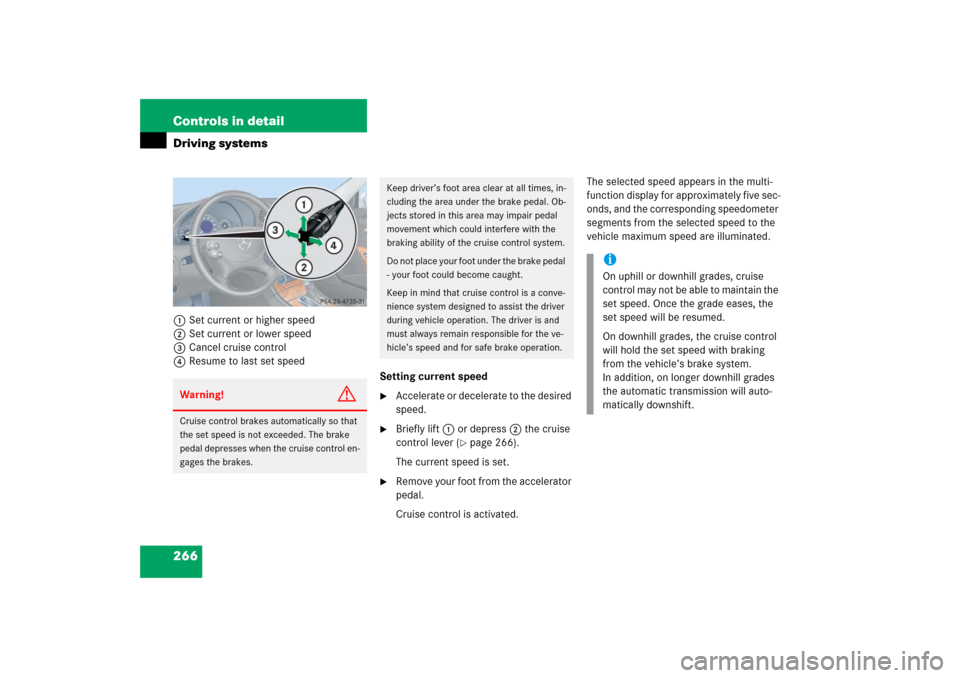
266 Controls in detailDriving systems1Set current or higher speed
2Set current or lower speed
3Cancel cruise control
4Resume to last set speed
Setting current speed
�
Accelerate or decelerate to the desired
speed.
�
Briefly lift1 or depress2 the cruise
control lever (
�page 266).
The current speed is set.
�
Remove your foot from the accelerator
pedal.
Cruise control is activated.The selected speed appears in the multi-
function display for approximately five sec-
onds, and the corresponding speedometer
segments from the selected speed to the
vehicle maximum speed are illuminated.
Warning!
G
Cruise control brakes automatically so that
the set speed is not exceeded. The brake
pedal depresses when the cruise control en-
gages the brakes.
Keep driver’s foot area clear at all times, in-
cluding the area under the brake pedal. Ob-
jects stored in this area may impair pedal
movement which could interfere with the
braking ability of the cruise control system.
Do not place your foot under the brake pedal
- your foot could become caught.
Keep in mind that cruise control is a conve-
nience system designed to assist the driver
during vehicle operation. The driver is and
must always remain responsible for the ve-
hicle’s speed and for safe brake operation.
iOn uphill or downhill grades, cruise
control may not be able to maintain the
set speed. Once the grade eases, the
set speed will be resumed.
On downhill grades, the cruise control
will hold the set speed with braking
from the vehicle’s brake system.
In addition, on longer downhill grades
the automatic transmission will auto-
matically downshift.
Page 268 of 514
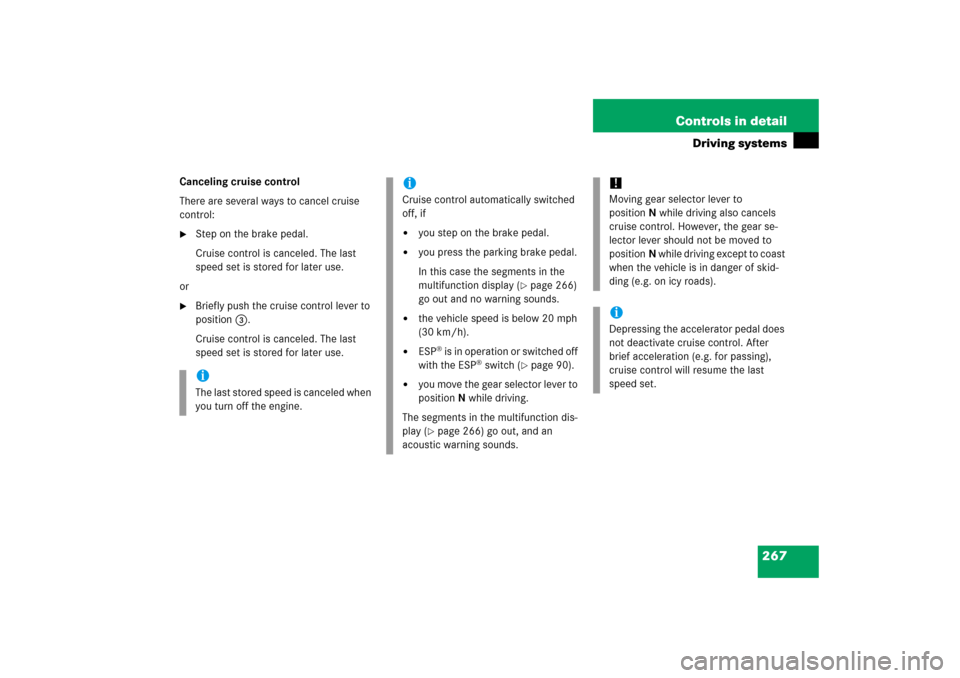
267 Controls in detail
Driving systems
Canceling cruise control
There are several ways to cancel cruise
control:�
Step on the brake pedal.
Cruise control is canceled. The last
speed set is stored for later use.
or
�
Briefly push the cruise control lever to
position3.
Cruise control is canceled. The last
speed set is stored for later use.iThe last stored speed is canceled when
you turn off the engine.
iCruise control automatically switched
off, if�
you step on the brake pedal.
�
you press the parking brake pedal.
In this case the segments in the
multifunction display (
�page 266)
go out and no warning sounds.
�
the vehicle speed is below 20 mph
(30 km/h).
�
ESP
® is in operation or switched off
with the ESP
® switch (
�page 90).
�
you move the gear selector lever to
positionN while driving.
The segments in the multifunction dis-
play (�page 266) go out, and an
acoustic warning sounds.
!Moving gear selector lever to
positionN while driving also cancels
cruise control. However, the gear se-
lector lever should not be moved to
positionN while driving except to coast
when the vehicle is in danger of skid-
ding (e.g. on icy roads).iDepressing the accelerator pedal does
not deactivate cruise control. After
brief acceleration (e.g. for passing),
cruise control will resume the last
speed set.
Page 269 of 514
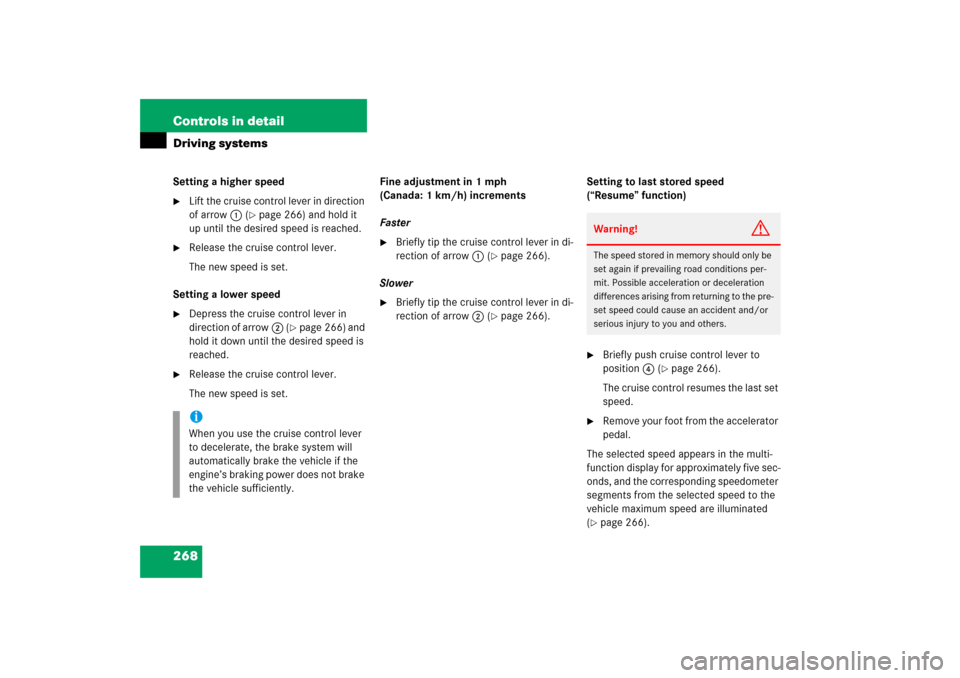
268 Controls in detailDriving systemsSetting a higher speed�
Lift the cruise control lever in direction
of arrow1 (
�page 266) and hold it
up until the desired speed is reached.
�
Release the cruise control lever.
The new speed is set.
Setting a lower speed
�
Depress the cruise control lever in
direction of arrow2 (
�page 266) and
hold it down until the desired speed is
reached.
�
Release the cruise control lever.
The new speed is set.Fine adjustment in 1 mph
(Canada: 1 km/h) increments
Faster
�
Briefly tip the cruise control lever in di-
rection of arrow1 (
�page 266).
Slower
�
Briefly tip the cruise control lever in di-
rection of arrow2 (
�page 266).Setting to last stored speed
(“Resume” function)
�
Briefly push cruise control lever to
position4 (
�page 266).
The cruise control resumes the last set
speed.
�
Remove your foot from the accelerator
pedal.
The selected speed appears in the multi-
function display for approximately five sec-
onds, and the corresponding speedometer
segments from the selected speed to the
vehicle maximum speed are illuminated
(
�page 266).
iWhen you use the cruise control lever
to decelerate, the brake system will
automatically brake the vehicle if the
engine’s braking power does not brake
the vehicle sufficiently.
Warning!
G
The speed stored in memory should only be
set again if prevailing road conditions per-
mit. Possible acceleration or deceleration
differences arising from returning to the pre-
set speed could cause an accident and/or
serious injury to you and others.